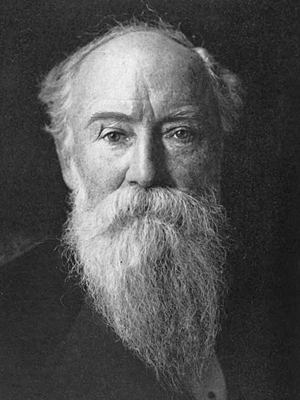
Homer Davenport, Famous Cartoonist, Pleads for Animals Tortured to Make Man’s Pleasure. In 1907 he created a series of cartoons for The Sunday Spokesman-Review from Spokane, Washington. Mr. Davenport’s purpose is to make unpopular the wanton slaughter of the wild life of America. The cartoons will be a powerful plea for the protection and preservation of the harmless creatures of the forests and the plains. Below is the entire series of 8 images, with text by Davenport and copyrighted for publication by Katharine Newbold Birdsall.

June 16, 1907: If you want to hunt any of the few remaining species of harmless wild game that this country has, by all means shoot it with a camera and not with a gun. You will get plenty of exercise, camping in the mountain air will do you good, and I know you will be happier when the trip is over than if you went on your vacation to kill. No one has ever told me any good reason for wanting to kill so beautiful a creature as a deer.
Out in the Rocky Mountains lives a man who understands human nature, that is, a big percentage of it. He knows that many of the men that hunt things to kill are vain.
He has fenced in several thousand acres as a private park, where the deer and elk breed and thrive as if in the wild state. They are naturally much tamer than other deer and elk. For during hard winters they are fed.
The proprietor of this almost natural park has grown wealthy by letting hunting privileges to a class that are willing to pay a big price that they may be photographed in the roles of heroes just after they have killed some innocent door or elk or bear. They would rather, of course, have the picture show them in the act of killing, but, as it is difficult to get good, clear negatives under such circumstances, they stand as the young hunter does in the cut above, making their best pose. The picture they mail to friends in the hope of winning admiration.
How many men would do this if they saw the pictures they are so proud of as others see them? How many men in those times of plentiful food would murder a beautiful, harmless little deer just for the privilege of being photographed, if they could realize the awfulness of the crime from the deer’s point of view? Posing for such a photograph would be bad enough were one’s family starving and it was necessary to kill deer for food. It’s bad enough to kill time in hunting with a gun, but think how much worse it is to kill time and also kill innocent animals.
When these sportsmen go to the Rockies to hunt and send home photographs showing them standing on the neck or ribs of some beautiful creature they have killed how careful they are not to write on the pictures, “I paid extra to hunt this half-tamed little deer in a fenced-in park, where it couldn’t get away, and when my rifle shot was heard through the trees a photographer rushed from the camera depot and made the picture.”
The sportsman who has his picture taken just after killing doesn’t tell you how carefully he opened the once sparkling eye, so that it, may look nearly as pretty in death as it did just before the crack of the rifle. He doesn’t go into details as to how he propped the deer’s head up with rocks, or how he stuck out his chest the moment the camera man said, “Ready.”
Instead, he writes: “I just happened to be photographed as I walked up and put a foot on a deer that I had shot a moment before after very difficult aim.”
Such sportsmen would have us believe that their feats were so remarkable that the photographers couldn’t resist the temptation to take aim with their cameras. No advertising of this mountain doesn’t preserve is needed. Hunters travel hundreds of miles to be photographed in it with their innocent prey. The deer and elk don’t destroy anything of value, and the men that kill them generally use the dead bodies for photographing purposes until the meat is spoiled.
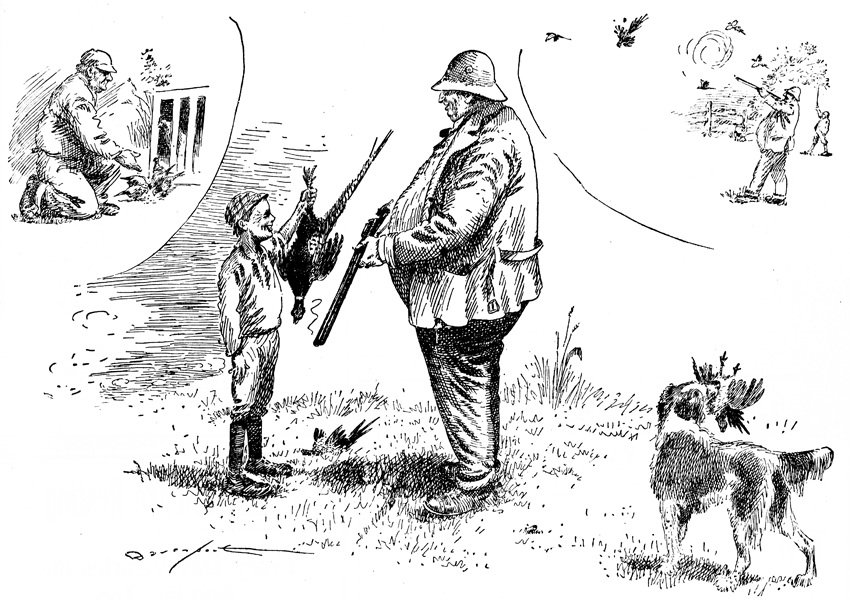
June 23, 1907: At least once a year we read in the papers cabled news of some member of royalty enjoying the slaughter of the beautiful pheasants which their gamekeepers have so tenderly reared during the previous spring. I remember once, when some offshoot of a certain king’s family came to see him, he celebrated the occasion by a big hunt among the young pheasants that had just gotten their fine plumage. The dispatch read something like this:
“The King and his guest, Prince so-and so, killed 700 pheasants today, and were so tired that they remained for the night at the king’s country estate, at so-and-so. The king enjoyed the day and out-shot, his guest. It. was the first shoot of the season and, considering the time of the year, the birds flew Very well. The king and his guest will shoot grouse tomorrow.”
When you read a dispatch like that, you wonder if the fact that several hundred wounded birds crawl away to suffer for several days and finally die ever bothers the royal sports.
The cartoon above doesn’t show royalty killing pheasant; it shows our home folks indulging in the slaughter. A king may be excused for killing pheasants, for he has nothing else to do to keep him from stumbling into all sorts of ruts. But with anyone else it’s different. This man in the picture doesn’t want birds for eating. He is suffering from indigestion, and possibly gout. Still, he is immensely pleased at the shot he has just made.
Is it his desire merely to kill? No, he has a curiosity to see a beautiful creature suddenly fall from the air.
A man in Oregon, whom I knew, was going on one occasion for a ten-mile drive, and someone remarked that he had better take a shotgun, as the young China pheasants were getting to be quite big. So he borrowed a gun. I went with him. We hadn’t gone more than three miles when we saw, just over the fence, a fine covey of pheasants–father, mother and nine half-grown young ones.
The man climbed out of the carriage quietly and tiptoed alongside the fence to where the blackberry bushes were thicker. Then, resting his gun on the fence, he took good aim. But he didn’t fire, and I asked him why not. He replied in a whisper that he was waiting till he could get more of the pheasants together. While he was waiting the male pheasant, as beautiful a specimen as you ever saw, picked a grub from the ground, and with a low note, called some of his young near, and as they bunched around the proud and glittering pheasant cock the man with the gun prepared to pull the trigger. The next moment his dyspepsia gave him a twinge of pain, he paused, let the hammers down on his gun and walked back to the buggy, some of the pheasants meanwhile flying away and the rest running off across the field.
When I asked him why he didn’t shoot, he said: “Why should I have killed and crippled that beautiful family? I saw they were enjoying life even more than we, as they were not bothered with dyspepsia, and I didn’t believe I had any right to inflict wanton pain on such beautiful, harmless creatures.”
Think of royalty, of others who can afford the expense, wanting to rear pheasants, and then, when the birds are just getting their full plumage, ordering the men that, have fed them from their hands to scare them up so that the owners can shoot them! And the hunters often in poor health from overfeeding! Just what sport there is in that sort of outing and “farming” is something I cannot fathom.
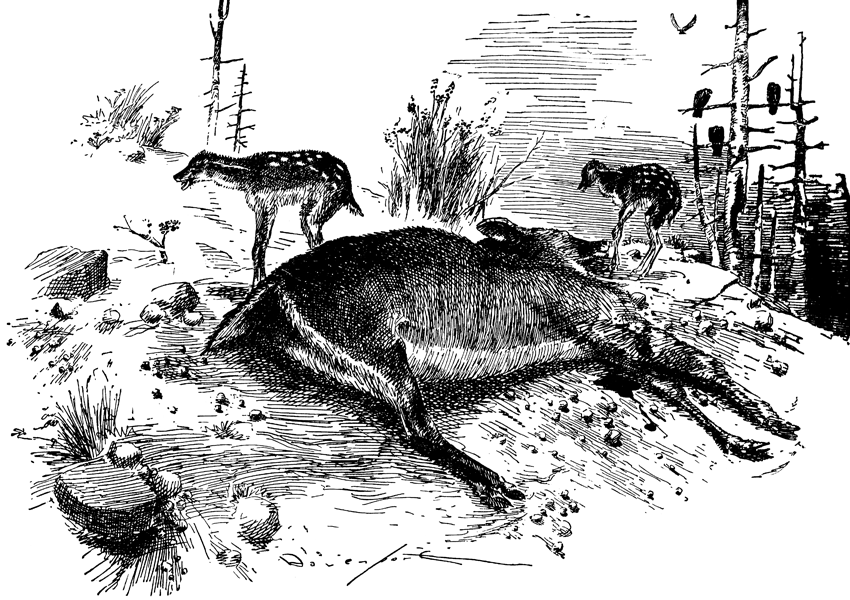
June 30, 1907: To those of us who are happy when we kill something this picture should be especially pleasing, because by shooting one the slayer killed three. The two little fawns will eventually starve to death and will be tender bits for the vultures waiting on the “bleachers.”
One would naturally think that a man, however thoughtless or heartless he may be, would not kill during the time of year when the wild mothers have young at their sides. But the fact is that game laws have to be provided for the protection of wild animals against the tame animals (men) during the early months of spring and summer, when the young of the wild animals are small. Nature protects them in a way against their animal enemies, such as wolves, bears and panthers, by giving them the power during that period to rid themselves of their scent to a certain degree and thus throw their pursuers off their trail. But nature overlooked the modern “sport” with the gun and his “sportsman’s spirit.” It takes more than the sight of the helpless young at the mother’s side to cause the killer not to shoot.
Cases are not uncommon every summer when campers in the mountains meet some bleating little fawn running up to beg to be fed. The mother has been shot just to satisfy the “sporting instinct” of some thoughtless human being, who couldn’t wait for the season to open.
Why is this season called the “shooting season?” Is it a season when we rush out with our guns and get meat enough to last for the rest of the year? Or is it that our families are craving for venison, and that we shoot to satisfy their wants? No, we have passed that stage; those that might appreciate the meat as food never have the time to hunt.
The so-called hunting season is a period apart to permit the men who must kill to satisfy that desire. That, as a race, we human beings are slowly improving is shown by the fact that as years go on our legislatures make the murdering season shorter.
Could any tragedy be more terrible than the killing of a harmless mother deer, who was at the time rearing her beautiful fawns far away from even a frontier settlement? Imagine the innocent suffering of these two little orphans! Imagine the starving little body of a growing baby! Imagine this little thing wondering why its silent mother does not satisfy it and give relief to the slow fever of starvation! Tragedies like this are constantly occurring in the woods, and just because some one is trying the sights on his new rifle.
When the early settler came and found his place swarming with wild animals, he killed them only for his food and safety. But as the game disappeared he didn’t follow them far, as a rule, but turned his thoughts to more worthy channels. He had work to do. As his sons grow up, he discouraged the keeping of guns. And we of today are improving. In time, it seems to me, the killing of harmless animals will have almost stopped. It would stop today if the hunter would only think before he pulls the trigger–if he would consider for a moment the beauties and pleasures that, must be in a deer’s life, bounding over mountains and through valleys, free from diseases that follow in the path of the caged animals.

July 7, 1907: Pictures like the one above are frequently posed for by men who take no interest in the conditions of life among wild birds or beasts other than to learn where they can be shot in the greatest numbers. Such men see few of the beauties of nature. Apparently they never are bothered by the fact that, they have killed more game than they can eat. But if the innocent animals that they destroy had souls, and these hunters were confronted suddenly by those souls, they might find it hard work to ease their minds.
How often we have seen in newspapers photographs of scenes, like the one herewith presented, showing some person proud of the fact that he is surrounded by a large quantity of game which he has killed. Here is a picture of supreme contentment, and triumph. The hunter is prouder than was Napoleon when he was reviewing his army. Few occasions are ever so important to this overfed, dyspeptic killer as when he is being photographed surrounded by the carcasses that have contributed to his day’s fun. The torture he has caused is nothing to him, not to speak of the great loss of bird and animal life. The dogs sometimes look ashamed in such pictures, but the great hero is very proud of his trigger finger and his splendid eye. He is at last a hero.
It is a very strange part of our nature, this desire to hold a killing bee. We soon would outgrow it, if we only studied the habits of harmless wild game. Then we would become aware of the pleasure they derive from life. We are foolish enough to excuse ourselves by saying, “Well, since I enjoy life as we do, and so there’s no harm in killing them.” Such ignorance! Untouched by the diseases that afflict the human race, the beautiful deer and wild birds lend a life so delightful that almost any human being would be thrown into ecstasies over one brief week of such an existence, if not pursued by men with guns.
Could a hunter see a doe rear her fawn, observing day by day her motherly care, and could he see the care bestowed and comfort taken by a pair of wild geese in rearing their little broods year by year, he would kill no more than was needed to satisfy hunger.
I believe we are waking up to the enormity of the crime of killing innocent game. I was present at a gun club dinner the other night, and the first speaker hit the nail on the head by saying that it was a strange sort of affair for him to attend, for he never had taken pleasure in trying to kill anything. And other speakers who had intended to tell of big hauls that they had made with the guns avoided the subject as a result of his example.
A young doctor who sat near me said that after he had killed almost everything that the law allowed him to, except wild turkeys, he was invited to go to the south by a friend, who assured him that he could give him some turkey shooting. After the doctor had shot two of the beautiful creatures he spared sixteen that had been tricked, one at a time, into answering an imitation of their own call. Instead of taking the lives of these birds of an almost extinct, glossy species from the blind where he was hidden, the doctor photographed them, and somehow he enjoyed the camera work more than he could have enjoyed using the gun.
This, coming from one who loved to shoot as well as any man, is encouraging. And if you want to attend a dry affair, go to a huntsmen’s dinner in a generation from now.
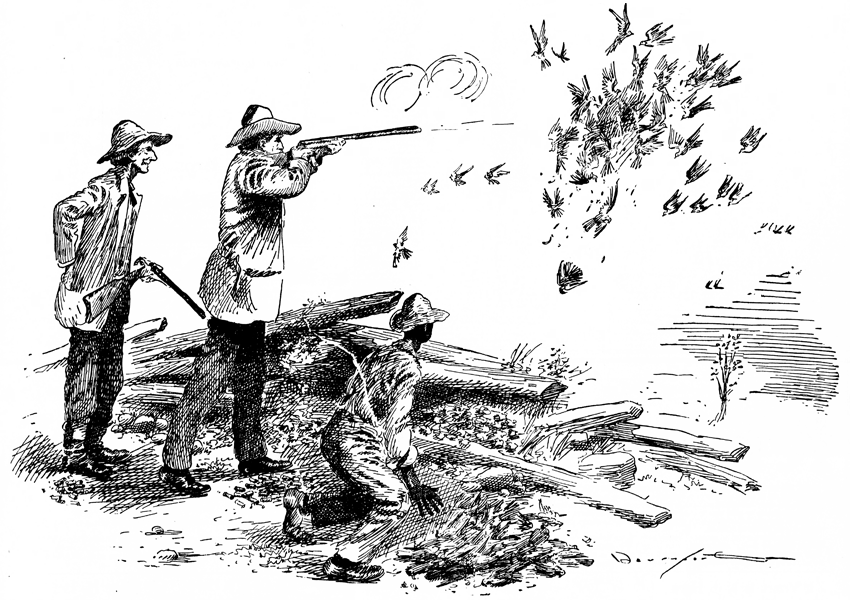
July 14, 1907: Any one who knows the habits and nature of turtle doves would no more imagine that they would be shot than that men would kill humming-birds. Yet they are slain by thousands while wintering in the South. These beautiful, dainty and easily tamed little birds have a peculiar, swift, darting flight. This appeals to a certain class of “sportsmen” who like to shoot at a fairly difficult flying mark.
If the farmer, who has enjoyed hearing the soft, mournful notes of a pair of doves that have rested regularly for years on a certain rail of the garden fence, misses these soothing notes when the time for their advent arrives, he may take it for granted that the birds have been killed on their winter migration.
In the South men who call themselves “sportsmen” feed the doves for several days in one spot, and thousands of these beautiful little wild pigeons are led to believe that man is really kind. They become so tame that they are easily tricked to their death by the shooters, who slaughter them by wholesale–and not for food.
After a big shoot the hunters bait the doves in a new place, feeding them for a week daily by leaving a bag of wheat scattered about the ground. After the doves’ confidence has been restored, the hunters again revel in the “sport” of bagging them, twenty or more at a shot.
No bird commands more sympathy than this dainty little mourning dove. It was never known to destroy anything, and it is a mystery why man should take pleasure in its indiscriminate slaughter. Why will they not be content to test their marksmanship on some other kind of target?
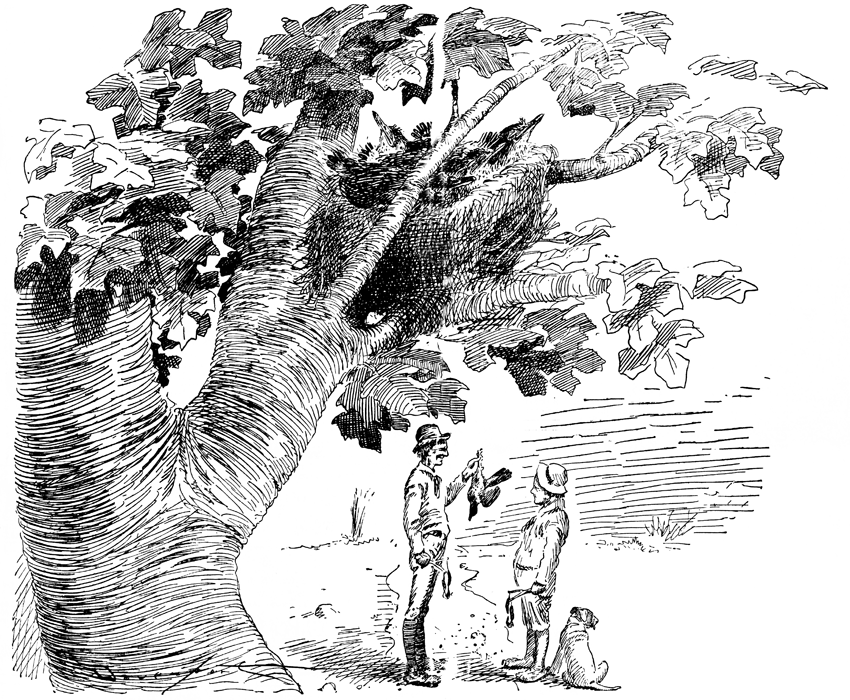
July 21, 1907: There are few boys who haven’t at some time in their lives, robbed bird’s nests. This does not mean that these boys are really cruel; that they kill and destroy with a desire to be inhuman. It, of course, means that they do not think. You cannot find a boy that would kill a robin with his sling shot, if he knew that, somewhere hidden away in a tree, there was a nest containing helpless young robins dependent entirely on the mother bird.
But you can find thousands of boys who would kill a robin, or any other bird, with a brand new slingshot without stopping to think of just what it means. Boys like to hunt and kill mainly because they hear the hunting stories of their elders. These stories take them through a wilder age, where the heroes hunt and kill. Airguns and slingshots that are made and offered for sale stimulate the killing instincts of children.
But there is no need to stop making airguns and slingshots. Our boys can keep on using these good old “weapons” if we will only give them the proper training. I believe the most hardened birds’-nest-robbing boy in New York would be reformed if he could spend a season with a man like John Burroughs (right). Such a naturalist as Mr. Burroughs could slow the boy how diligently the mother and father birds work to build their nest and to rear their young and with what care they protect their nestlings. He could teach him to see the real beauty of the birds’ life.
To know well the difference in species of birds at once lessens the desire to kill. To see, year after year, the same bluebirds return to the same birdhouse to nest; to watch the orioles weave and lace their stocking-like nests–if this is once taught and explained to a boy, even if he is an expert with a slingshot, the finer side of his nature will rule and he will have less desire to aim his boyish “weapon” at a feathered mark.
Killing by boys, anyway, is done for the most part to study the bird or animal at close range. It takes only a brief explanation to convince a boy that to kill a beautiful creature just to see the few red feathers of his neck or the blue feathers of his wings is heartless as well as foolish.
Reverse the process. Imagine the horror and sadness in the world if a certain kind of bird, just to tell whether boys had blue or brown eyes, killed children! You have, however, seen boys exhibiting with pride some beautiful little wild canary they lulled as he sang on the back yard fence. They were attracted first by this bird’s beautiful song, next by his pretty plumage. They knew when they killed him that the song would stop, never to be heard again, but they wanted to examine his bright yellow breast at closer range.
An hour’s talk a week would stop boys from depredations of this kind–they would awake to the fact that a life is a life.
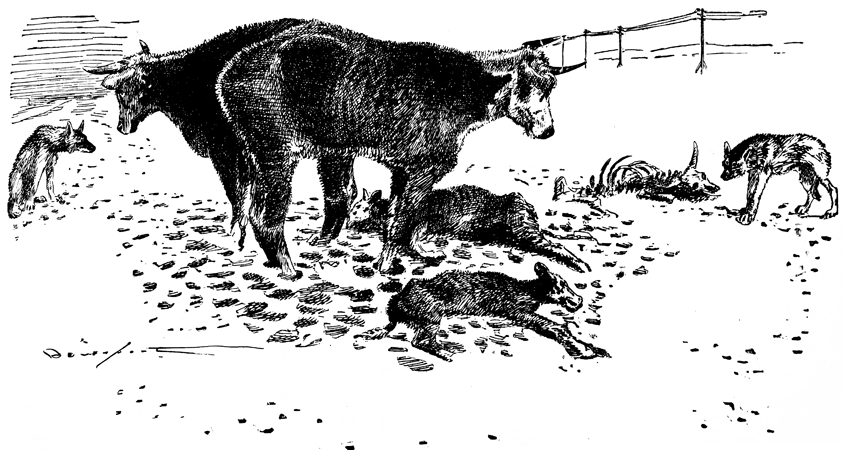
July 28, 1907: It is easy to believe that Mrs. Minnie Maddern Fiske (right), the great actress, was moved to tears by the sights she saw from the car windows as she was crossing the continent during the winter months. Mrs. Fiske deserves great credit for her courage in being the pioneer in a crusade against the rich cattle range owners of the west. I am glad to join her as a weak understudy to help point the finger of shame, if it is possible, at the millionaire who would rather let one-third of his cattle suffer and starve to death than spend a little money for their protection.
The big cattlemen of the west are a queer class. They make vast fortunes from their herds with little expense; none, in fact, in the way of feed or shelter.
There is an element of the gambler in their makeup. If it is a light winter their profits are enormous, for the next season’s grass without cost makes their cattle fat. If the winter is a hard one, with lots of snow, and the cows and their calves die by thousands–that is part of the game. At the worst, no money is wasted in furnishing food and shelter for the herds. Pastured in lands illegally owned in many instances, herded by the wolves that feed upon the calves and older and weaker cows, the only expense is a few stock bulls and some of the cheapest salt. But a hundred thousand tons of wild hay could be cut and stacked with little cost. This, while it would save the calves by the hundreds of thousands, would be spending money when perhaps a very “open” winter would bring a pretty good percentage of their cattle through alive, though with cruel suffering.
You wonder, as Mrs. Fiske wonders, that, when some of these cattle kings are wintering in the art galleries of Paris and New York, paying for a single picture what would have saved 20,000 mother cows and calves, they are not confronted by a mental picture of a starving herd–the once beautiful calf dead from hunger and cold, the mother displaying the true love that only mothers have, trying to protect the corpse of her baby from the wolves.
No imagination could overdraw the suffering of these homeless cattle. At winter’s first warning they wander bellowing mile after mile, hoping that, though nature has failed to provide, their owner has not forgotten them. They wander wasting the strength that they will need so much before spring comes. They are followed by the wolves eager for the younger calves. They call, but no answer comes save from the wolf and coyote. The snow pelts them in the face and they bunch and wait through the long nights, their bodies nourished only by the flesh stored when the grass was good. They find the watering hole where they used to quench their thirst, but alas, that is frozen over; at every turn the wolves, like ghosts, are always eyeing them. Winter grows more severe. They die from starvation or are killed by the great wolves. Spring is slow in coming.
All this time their wealthy owners are mildly interested as to what percentage of cattle “got through.”
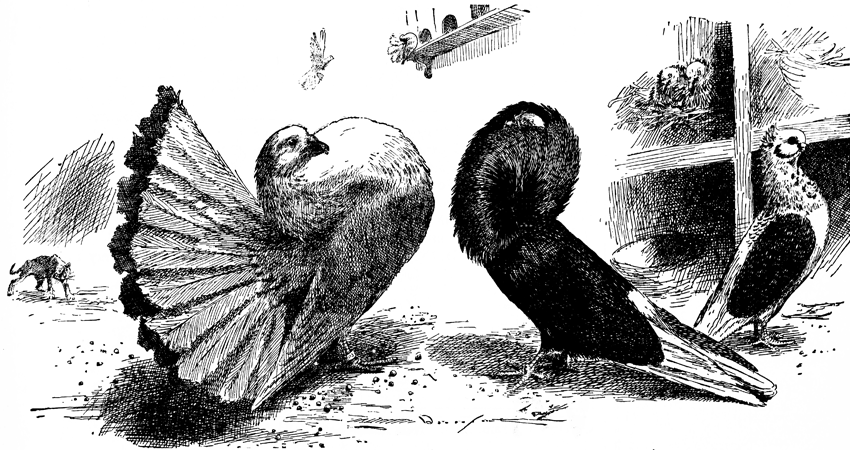
August 4, 1907: To every observing person who visits the great pigeon shows of the present day one form of cruelty to animals must be apparent. It is seen in the creations man has evolved from the old common Blue Rock pigeon. Because many men seldom think along humane lines the pigeon suffers all his life, merely to suit the fads and fancies of persons who call themselves “breeders.”
Imagine Burbank creating a pear tree that didn’t produce fruit, or a vine, that, just after starting up, turned and grew back to the ground. No one would give this man, whose fame has gone around the world, respectful attention.
What a howl would go up if some society was organized to bring about the marriage of hunchbacked people, thereby establishing a deformed race. Steps would immediately be taken to break up the movement, and rightly. To my mind people attempting to raise the fan-tail pigeon, that trembles as he strains in his effort to stand, should be stopped by the state, for they are creating an unhappy creature in violation of the laws of nature.
The high-class fan-tail pigeon is a tiresome creature, to behold. There is no such thing for him as a restful position. Feed him with other pigeons and they will eat all the food before he can get his head to the ground. If he sees a cat or other menace approaching, he becomes a nervous wreck and can’t fly.
The pigeon is unable to help himself. He is mated against his will with another in as bad a plight, and the union of such produces a bird that tips his head until it is behind his tail. And yet men receive medals for success in developing such species!
The Jacobin pigeon has had its hood developed until it is unable to see. It has to grope around in the loft to find feed and water. It is no good at flying, and only with great difficulty would it find its way back to its nest. There is no wonder that it is helpless to escape from hawks and rats. And yet the Jacobin was once a happy bird, capable of flying and enjoying life to the full. It had a small ruffle on its neck which caused no trouble. This furnished an excuse for man to overdo nature beyond all reason. The Jacobin has a gloomy existence merely to make some fancier happy.
The short-billed pigeons also suffer seriously from man’s ingenuity in creating freaks. They are bred now until the bill has practically disappeared. As the dove family breeds its young by the parent taking the offspring by the bill, it is growing more difficult for the short billed pigeons to perform this duty, so most of them die in the nest when a day or two old. Accordingly, the breeder can say truthfully that few of them are reared and he can command high prices. Men who raise degenerate creatures that are curses to themselves for a reason they don’t understand should be punished by the law.





